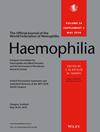Investigation of the Relationship Between Self-Management and Kinesiophobia in Haemophiliac Individuals Experiencing Intra-Articular Bleeding
Abstract
Introduction
This study aims to examine the relationship between self-management skills and kinesiophobia in haemophilia patients. The findings of the study may contribute to the development of strategies that can help haemophilia patients overcome their fear of movement and improve their quality of life (QoL).
Aim
This study is planned to examine the relationship between disease self-management in haemophiliac individuals and kinesiophobia that may arise from intra-articular bleeding associated with haemophilia.
Methods
In this study, both descriptive and analytical research was conducted on individuals who are members of patient associations. Patient Identification Form, Chronic Disease Self-Management Scale and Tampa Scale for Kinesiophobia were used as data collection tools. Data were collected face to face. Descriptive statistics methods (mean, standard deviation) were used in the evaluation of study data. Quantitative data comparisons were made with the Student's t-test for normally distributed parameters and the Mann–Whitney U test for non-normally distributed parameters. When there were more than two groups, One-Way ANOVA was used, and in advanced analyses, linear regression analysis was used.
Results
A positive correlation was found between the ‘self-stigmatization’ subdimension of the Chronic Disease Self-Management Scale and kinesiophobia. Additionally, a negative correlation was observed between healing compliance and kinesiophobia levels. Flexibility in healing cracks was found in the reduction of kinesiophobia.
Conclusion
Self-management of the disease in hemophilic individuals affects compliance with treatment, kinesiophobia, activity level and QoL.

 求助内容:
求助内容: 应助结果提醒方式:
应助结果提醒方式:


